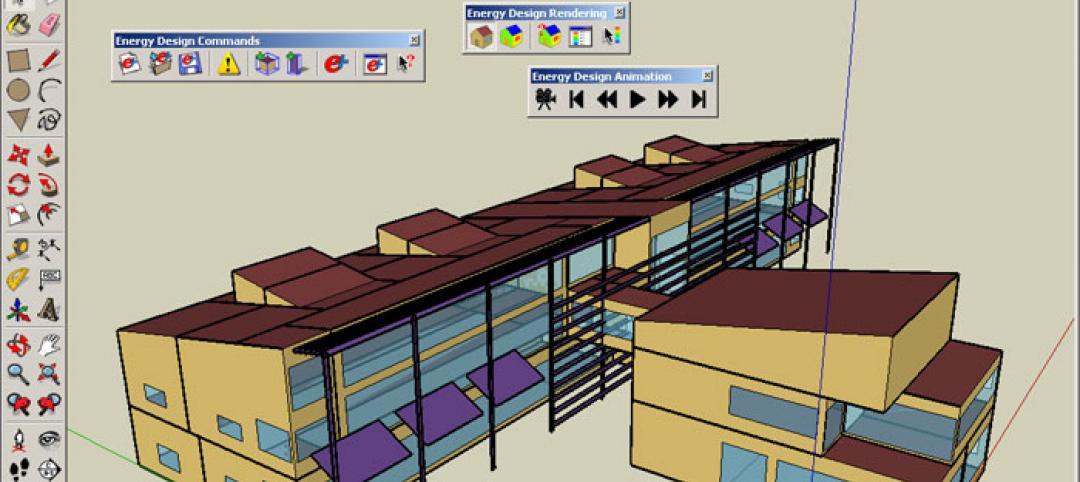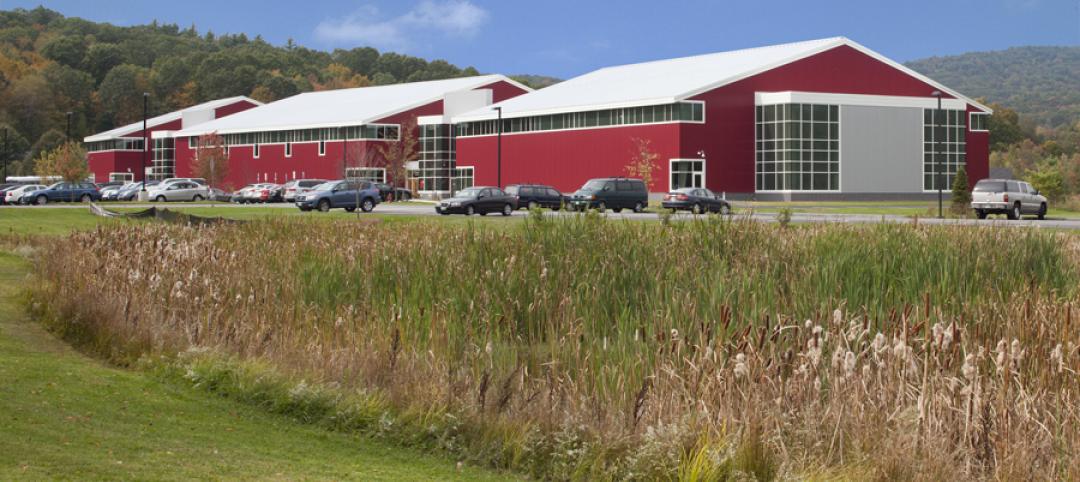Designed by Pietro Belluschi, the Juilliard School in New York’s Lincoln Center for the Performing Arts had remained relatively untouched since its completion in 1969. In the early 2000s, a plan was conceived to make Lincoln Center—and Juilliard—more architecturally engaged with the general public and its Upper West Side neighbors.
In an effort to offer additional educational opportunities to the growing number of students, officials at the school sought to add 39,000 sf of classrooms, practice rooms, and rehearsal spaces, as well as two new performance venues. The design also called for more informal social spaces for students and greater access to daylight, as well as an upgrade of the public entrance to integrate the building—a classic example of the Brutalist movement—more fully into the landscape of the Lincoln Center campus.
Renovating on the Upper West Side
Working with a Building Team that included a design collaboration between New York-based firms FXFOWLE Architects and Diller Scofidio + Renfro, engineering firms Arup and Langan Engineering & Environment Services, and Turner Construction Co., the administration sought to preserve the iconic elements of Belluschi’s design while meeting the needs of students and creating a more public identity for the building.
Numerous stakeholders had to be consulted—this is, after all, New York—from academic department heads to Lincoln Center’s 14 other constituent organizations, as well as the New York City Department of Planning, neighborhood and community boards, and the New York State Historic Preservation Office.
Moreover, the Building Team was to undertake the project while Juilliard remained fully occupied and functional. With an institution whose very soul relied on quality acoustics for its existence, mitigating sound during construction was a primal concern for the Building Team. “The challenge in renovating the antiquated, Brutalist space was to perform surgery on part of the building while still allowing full bodily function of the other organs,” says Heidi Blau, AIA, LEED AP, a partner at FXFOWLE.
PROJECT SUMMARY
The Juilliard School Renovation and Expansion, New York City, N.Y.
Building Team
Owner/developer: The Juilliard School
Architects: FXFOWLE Architects (submitting firm) and Diller Scofidio + Renfro
Structural engineer: Arup
Civil engineer: Langan Engineering & Environment Services
GC/CM: Turner Construction Co.General Information
Size: 39,000 sf
Construction cost: Confidential at owner’s request
Construction period: 2005 to 2010
Delivery method: CM
To meet these demands, a sophisticated plan of phasing, relocation, use of temporary facilities, and incremental reoccupation was developed. Blau says she envisioned the process as one “where one facet might undergo a transformation without disrupting the integrity of the project as a whole.” The use of swing space was an important strategy. For example, an infill interior courtyard was made into a temporary classroom; later, the space was converted to a permanent orchestra rehearsal room.
Opening up to the community
For more than four decades, the Juilliard building presented a fortress-like appearance to the surrounding community, a manifestation of the Brutalist design that Blau says “reflected a cloistered approach to the arts.” The Lincoln Center campus master plan called for a more open and inviting Juilliard.
The first step was to open up Juilliard’s entryway into a three-story lobby, thereby extending a warm welcome to visitors entering from 65th Street. The glass lobby connects spaces at street level, where many public programs are offered, to the student lounge on the second level and administration offices on the third. LED information boards, computer terminals, and a coffee bar invite more opportunities for students to meet and socialize; a glass box office is easily accessible to visitors and patrons. The lobby’s new grand staircase contains specially cut sections that provide communal spaces for those in transit from one floor to another, a feature that the BD+C Reconstruction Awards jury, notably juror Martha Bell, FAIA, found “very interesting.”
The façade, with its three-story glass curtain walls along Broadway, entices neighbors and passersby to look in, while at the same time projecting the school’s energy out into the community. The glass wall brings much more natural daylight into the school’s once dark, labyrinthine interiors.
Staying true to form
All this, while still retaining Belluschi’s stone details elsewhere on the exterior elevations. “The building façade includes more than 10 different types of glass in order to meet the distinct technical requirements of strength, acoustics, and thermal performance of the exterior wall,” says Peter Pesce, AIA, a senior associate at FXFOWLE. “Matching the original stone details while employing modern construction techniques proved challenging.”
Respecting the original Brutalist design was important to the Building Team. Travertine cladding was used from the very quarry where the original was mined, providing continuity of materials. Says Blau, “The careful surgery performed on Pietro Belluschi’s building was predicated on the existence of robust bones—able to support the transformation while retaining a significant portion of the existing travertine and concrete.”
Taking on the renovation of one of New York City’s cultural treasures required not only an appreciation for the original design, but also a sensitivity to the legitimate concerns of numerous stakeholders. The renovation and expansion of the Juilliard School has transformed the revered institution into a more modern performing arts center while preserving its architectural heritage. It is for these reasons that our Reconstruction Awards jury has designated this project as a Bronze winner. +
Related Stories
| Feb 10, 2014
Proposed parking garage will sandwich vehicles between housing and retail space
Architecture firm Brisac Gonzalez says that the design "will introduce different activities after parking hours."
| Feb 10, 2014
Architecture Design Collaborative announces firm opening in Southern California
Today, Architecture Design Collaborative officially announces the launch of its firm providing a full range of architecture and interior design services nationwide. Architecture Design Collaborative offers architectural design services, comprehensive interior design services, developer collaboration, direct tenant improvement, repositioning and site planning.
| Feb 10, 2014
Ball State to host Geothermal Conference on design, drilling and equipment - April 10, 2014
To best serve the industry, Ball State University has organized a single day conference in which participants will be able to exchange technical notes, develop understandings and share experiences with design, drilling, and equipment issues related to geothermal ground source heat pump technology.
| Feb 7, 2014
DOE, Autodesk team to overhaul the EnergyPlus simulation program
The update will allow a larger ecosystem of developers to contribute updates to the code in order to improve performance and decrease the time required to run energy model simulations.
| Feb 7, 2014
Meet the new Fellows: AIA elevates 143 to College of Fellows
The AIA College of Fellows is an honor awarded to members who have made significant contributions to the architectural profession.
| Feb 7, 2014
Bernards announces executive leadership realignment
Changes reflect long-term growth plans as builder enters its fifth decade.
| Feb 7, 2014
Zaha Hadid's 'white crystal' petroleum research center taking shape in the desert [slideshow]
Like a crystalline form still in the state of expansion, the King Abdullah Petroleum Studies and Research Center will rise from the desert in dramatic fashion, with a network of bright-white, six-sided cells combining to form an angular, shell-like façade.
| Feb 6, 2014
First look: Gensler ups the ante on airport design with new SFO boarding area
The new terminal features a yoga room, award-winning arts program, and an interactive play area for kids.
| Feb 6, 2014
End of the open workplace?
If you’ve been following news about workplace design in the popular media, you might believe that the open workplace has run its course. While there’s no shortage of bad open-plan workplaces, there are two big flaws with the now common claim that openness is bad.
| Feb 6, 2014
New Hampshire metal building awes visitors
Visitors to the Keene Family YMCA in New Hampshire are often surprised by what they encounter. Liz Coppola calls it the “wow factor.” “Literally, there’s jaw dropping,” says Coppola, director of financial and program development for the Keene Family YMCA.













